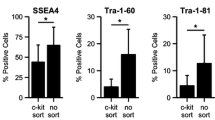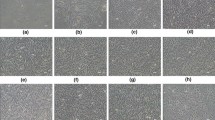Abstract
Amniotic fluid (AF) contains heterogeneous and multipotential cell types. A pure mesenchymal stem cells group can be sorted from AF using flow cytometry. In order to evaluate a possible therapeutic application of these cells, the human AF-derived c-kit+ stem cells (c-kit+ AFS) were compared with the c-kit− (unselected) stem cells (c-kit− AFS). Our findings revealed that the optimal period to obtain c-kit+ AFS cells was between 16 and 22 weeks of gestation. Following cell sorting, c-kit+ AFS cells shared similar morphological and proliferative characteristics as the c-kit− AFS cells. Both c-kit+ and c-kit− AFS cells had the characteristics of mesenchymal stem cells through surface marker identification by flow cytometric and immunocytochemical analysis. Both c-kit+ and c-kit− AFS cells could differentiate along adipogenic and osteogenic lineages. However, the myocardial differentiation capacity was enhanced in c-kit+ AFS cells by detecting GATA-4, cTnT, α-actin, Cx43 mRNA and protein expression after myocardial induction; whereas induced c-kit− AFS cells were only detected with GATA-4 mRNA and protein expression. The c-kit+ AFS cells could have potential clinical application for myogenesis in cardiac regenerative therapy.






Similar content being viewed by others
References
Antin PB, Bales MA, Zhang W, Garriock RJ, Yatskievych TA, Bates MA (2002) Precocious expression of cardiac troponin T in early chick embryos is independent of bone morphogenetic protein signaling. Dev Dyn 225:135–141
Arnhold S, Glüer S, Hartmann K, Raabe O, Addicks K, Wenisch S, Hoopmann M (2011) Amniotic-fluid stem cells: growth dynamics and differentiation potential after a CD-117-based selection procedure. Stem Cells Int 2011:715341
Castro-Malaspina H, Gay RE, Resnick G, Kapoor N, Meyers P, Chiarieri D, McKenzie S, Broxmeyer HE, Moore MA (1980) Characterisation of human bone marrow fibroblast colony-forming cells (CFU-F) and their progeny. Blood 56:289–301
Civin CI, Trischmann T, Kadan NS, Davis J, Noga S, Cohen K, Duffy B, Groenewegen I, Wiley J, Law P, Hardwick A, Oldham F, Gee A (1996) Highly purified CD34-positive cells reconstitute hematopoiesis. J Clin Oncol 14:2224–2233
Da Sacco S, Sedrakyan S, Boldrin F, Giuliani S, Parnigotto P, Habibian R, Warburton D, De Filippo RE, Perin L (2010) Human amniotic fluid as a potential new source of organ specific precursor cells for future regenerative medicine applications. J Urol 183:1193–1200
De Coppi P, Bartsch G Jr, Siddiqui MM, Xu T, Santos CC, Perin L, Mostoslavsky G, Serre AC, Snyder EY, Yoo JJ, Furth ME, Soker S, Atala A (2007) Isolation of amniotic stem cell lines with potential for therapy. Nat Biotechnol 25:100–106
Deans RJ, Moseley AB (2000) Mesenchymal stem cells: biology and potential clinical uses. Exp Hematol 28:875–884
Dominici M, Le Blanc K, Mueller I, Slaper-Cortenbach I, Marini F, Krause D, Deans R, Keating A, Prockop Dj, Horwitz E (2006) Minimal criteria for defining multipotent mesenchymal stromal cells. The International Society for Cellular Therapy position statement. Cytotherapy 8:315–317
Evans MJ, Kaufman MH (1981) Establishment in culture of pluripotential cells from mouse embryos. Nature 292:154–156
Fleischman RA (1993) From white spots to stem cells: the role of the Kit receptor in mammalian development. Trends Genet 9:285–290
Gronthos S, Franklin DM, Leddy HA, Robey PG, Storms RW, Gimble JM (2001) Surface protein characterization of human adipose tissue-derived stromal cells. J Cell Physiol 189:54–63
Heng BC, Haider HKh, Sim EK, Cao T, Ng SC (2004) Strategies for directing the differentiation of stem cells into the cardiomyogenic lineage in vitro. Cardiovasc Res 62:34–42
Laird DW (2010) The gap junction proteome and its relationship to disease. Trends Cell Biol 20:92–101
Le Blanc K, Ringdén O (2005) Immunobiology of human mesenchymal stem cells and future use in hematopoietic stem cell transplantation. Biol Blood Marrow Transplant 11:321–334
Lloyd-Jones D, Adams RJ, Brown TM, Carnethon M, Dai S, De Simone G, Ferguson TB, Ford E, Furie K, Gillespie C, Go A, Greenlund K, Haase N, Hailpern S, Ho PM, Howard V, Kissela B, Kittner S, Lackland D, Lisabeth L, Marelli A, McDermott MM, Meigs J, Mozaffarian D, Mussolino M, Nichol G, Roger VL, Rosamond W, Sacco R, Sorlie P, Stafford R, Thom T, Wasserthiel-Smoller S, Wong ND, Wylie-Rosett J, American Heart Association Statistics Committee and Stroke Statistics Subcommittee (2010) Executive summary: heart disease and stroke statistics-1010 update: a report from the American heart association. Circulation 121:948–954
Mafi R, Hindocha S, Mafi P, Griffin M, Khan WS (2011) Adult mesenchymal stem cells and cell surface characterization: a systematic review of the literature. Open Orthop J 2:253–260
Martin GR (1981) Isolation of a pluripotent cell line from early mouse embryos cultured in medium conditioned by teratocarcinoma stem cells. Proc Natl Acad Sci USA 78:7634–7638
Oma Y, Harata M (2011) Actin-related proteins localized in the nucleus from discovery to novel roles in nuclear organization. Nucleus 2:38–46
Perin L, Sedrakyan S, Giuliani S, Da Sacco S, Carraro G, Shiri L, Lemley KV, Rosol M, Wu S, Atala A, Warburton D, De Filippo RE (2010) Protective effect of human amniotic fluid stem cells in an immunodeficient mouse model of acute tubular necrosis. PLoS ONE 5:e9357
Peruga J, Plewka M, Kasprzak J (2009) Intracoronary administration of stem cells in patients with acute myocardial infarction-angiographic follow-up. Kardiol Pol 67:477–484
Phermthai T, Odglun Y, Julavijitphong S, Titapant V, Chuenwattana P, Vantanasiri C, Pattanapanyasat K (2010) A novel method to derive amniotic fluid stem cells for therapeutic purposes. BMC Cell Biol 11:79
Pittenger MF, Mackay AM, Beck SC, Jaiswal RK, Douglas R, Mosca JD, Moorman MA, Simonetti DW, Craig S, Marshak DR (1999) Multilineage potential of adult human mesenchymal stem cells. Science 284:143–147
Prusa AR, Marton E, Rosner M, Bernaschek G, Hengstschläger M (2003) Oct-4-expressing cells in human amniotic fluid: a new source for stem cell research? Hum Reprod 18:1489–1493
Ripa RS, Jørgensen E, Wang Y, Thune JJ, Nilsson JC, Søndergaard L, Johnsen HE, Køber L, Grande P, Kastrup J (2006) Stem cell mobilization induced by subcutaneous granulocyte-colony stimulating factor to improve cardiac regeneration after acute ST-elevation myocardial infarction result of the double-blind, randomized, placebo-controlled stem cells in myocardial infarction (STEMMI) trial. Circulation 113:1983–1992
Tendera M, Wojakowski W, Ruzyłło W, Chojnowska L, Kepka C, Tracz W, Musiałek P, Piwowarska W, Nessler J, Buszman P, Grajek S, Breborowicz P, Majka M, Ratajczak MZ, REGENT Investigators (2009) Intracoronary infusion of bone marrow-derived selected CD34+ CXCR4+ cells and non-selected mononuclear cells in patients with acute STEMI and reduced left ventricular ejection fraction: results of randomized, multicentre Myocardial Regeneration by Intracoronary Infusion of Selected Population of Stem Cells in Acute Myocardial Infarction (REGENT) Trial. Eur Heart J 30:1313–1321
Yeh YC, Wei HJ, Lee WY, Yu CL, Chang Y, Hsu LW, Chung MF, Tsai MS, Hwang SM, Sung HW (2010) Cellular cardiomyoplasty with human amniotic fluid stem cells: in vitro and in vivo studies. Tissue Eng Part A 16:1925–1936
Acknowledgments
The authors wish to thank Yajun Guo, Sheng hou, Xin Tong, Lei Zheng and Liangliang Wu for expert technical assistance.
Author information
Authors and Affiliations
Corresponding author
Additional information
Jing Bai and Yiru Wang have the same contribution to this manuscript.
Rights and permissions
About this article
Cite this article
Bai, J., Wang, Y., Liu, L. et al. Human amniotic fluid-derived c-kit+ and c-kit− stem cells: growth characteristics and some differentiation potential capacities comparison. Cytotechnology 64, 577–589 (2012). https://doi.org/10.1007/s10616-012-9441-6
Received:
Accepted:
Published:
Issue Date:
DOI: https://doi.org/10.1007/s10616-012-9441-6




